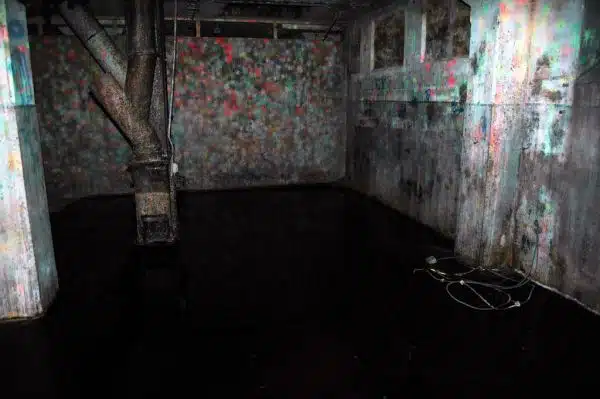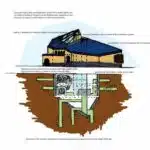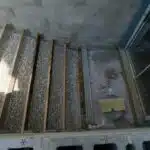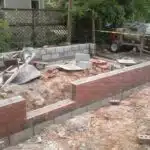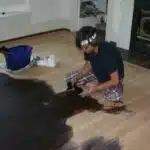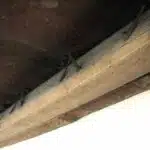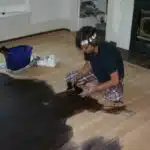Basement moisture is a common problem that many homeowners face. It can lead to a range of issues, including the growth of mold and mildew, which can negatively impact the health of those living in the home. Additionally, moisture can cause structural damage to a home’s foundation, making it imperative to address the problem as soon as possible.
As an expert in basement moisture control and prevention, I have seen firsthand the damage that moisture can cause if left unchecked. In this article, I will provide practical solutions for fixing basement moisture, ranging from simple DIY methods to more advanced techniques that may require professional help. By following these steps, homeowners can protect their homes and loved ones from the harmful effects of excess moisture while also improving their overall quality of life.
Identifying The Cause Of Basement Moisture
Imagine that your basement is like a ship, sailing through the rough waters of life. However, unlike a ship, your basement is not immune to leaks and moisture. Common misconceptions suggest that basements are naturally damp environments, but this couldn’t be further from the truth. Moisture in basements can lead to mold growth, musty smells, and even damage to the foundation of your home. As an expert in basement moisture, it’s essential to identify the cause of the moisture before taking any steps towards repair.
One prevention tip is to ensure proper ventilation in your basement. Without sufficient airflow, moisture can accumulate and lead to problems down the line. Another common misconception is that waterproofing paint can solve all issues related to basement moisture; however, this is not always the case. Water can still seep through cracks and gaps in the foundation regardless of paint application. It’s crucial to keep these factors in mind when attempting to fix basement moisture.
To identify the cause of your basement moisture, you’ll need to inspect for leaks and cracks thoroughly. This process involves checking for visible water damage on walls and floors as well as examining pipes for any signs of leakage. Once you’ve determined where the moisture is coming from, you can move onto implementing necessary repairs or preventative measures.
Checking For Leaks And Cracks
Basement leaks and cracks are the most common culprits of moisture in basements. Identifying these leaks and cracks can be tricky, but it is necessary to stop the moisture from seeping in. One way to identify leaks and cracks is by looking for water stains on the walls or floors. If you notice any damp spots or discoloration, it could be a sign of a leak.
Another way to identify leaks and cracks is by using a flashlight to inspect your basement walls and floors. Look for any holes, gaps or openings that may allow water to seep in. Check around pipes, windows, doors, and vents as they are common areas where water enters basements. It is important to fix all identified leaks and cracks promptly as they could lead to bigger problems if left unattended.
Repairing basement leaks and cracks can be done by following these steps:
- Clean the area around the leak or crack using a wire brush or sandpaper.
- Fill the hole with hydraulic cement, which expands as it dries.
- Cover the area with waterproof sealant that will prevent future moisture penetration.
Remember that properly sealing your basement against leaks involves more than just plugging holes found in walls or floors. Make sure you also address issues such as grading outside your home’s foundation that may contribute to excess water accumulation near your home’s foundation.
Moving forward into evaluating drainage systems, it is important to understand how proper drainage can significantly reduce basement moisture problems.
Evaluating Drainage Systems
After checking for leaks and cracks, the next step in fixing basement moisture is evaluating drainage systems. The importance of slope cannot be overstated when it comes to proper drainage. A negative slope towards the foundation can cause water to pool around the perimeter of the house, increasing the risk of water infiltration into the basement. Therefore, it is essential to ensure that there is a positive slope away from the foundation.
One effective way to improve drainage is through French drain installation. A French drain consists of a perforated pipe surrounded by gravel and covered with soil or turf. It helps divert groundwater away from the foundation and towards a designated drainage area, preventing water buildup around the house. It is important to note that installing a French drain may require professional help as it involves excavation and knowledge of local building codes.
Table: Pros and Cons of Different Drainage Systems
| Drainage System | Pros | Cons |
|---|---|---|
| Surface Drainage | Easy to install | Not very effective against heavy rainfalls |
| Interior Drainage | Effective at removing water already in basement | Can be costly |
| Exterior Drainage | Most effective at preventing moisture infiltration | Requires professional installation |
Assessing humidity levels in your basement will be discussed in detail in the following section. By evaluating your drainage systems properly, you can significantly reduce moisture buildup in your basement, which can lead to a range of problems like mold growth, musty odors and damage to furniture or stored items. In addition, efficient drainage systems can also prevent structural damage caused by long-term exposure to moisture. If you are experiencing issues with basement moisture, addressing these factors should be your first priority before moving on to other measures such as dehumidifiers or waterproof coatings.
Assessing Humidity Levels
One of the most important steps in fixing basement moisture is assessing humidity levels. This is because excessive humidity can lead to the growth of mold and mildew, which can cause health problems for inhabitants of the home. Additionally, high levels of humidity can cause damage to wood, metal, and other materials in the basement.
To accurately assess humidity levels in your basement, it is important to use a hygrometer. A hygrometer is a tool that measures relative humidity in the air. There are many different types of hygrometers available on the market, but digital models tend to be more accurate than analog models. It is also recommended to take measurements at various locations throughout the basement to get a good overall picture of the moisture levels.
Once you have assessed your basement’s humidity levels, you can take steps to improve ventilation and reduce moisture. This can include installing vents or fans, sealing cracks or leaks in walls and floors, or using a dehumidifier. By reducing excess moisture in your basement, you can prevent damage to your home and protect your family’s health.
- Use a digital hygrometer for accuracy
- Take measurements at various locations throughout the basement
- Consider implementing ventilation improvements such as fans or vents
Assessing humidity levels is an essential first step in fixing basement moisture issues. Using a hygrometer will help ensure accuracy when measuring relative humidity in your home’s basement. Once you have determined whether there are high levels of humidity present, you can take steps to improve ventilation and reduce moisture. In the next section, we will discuss how improving ventilation can help alleviate basement moisture concerns.
Improving Ventilation
Exhaust fans are a valuable tool in improving ventilation and reducing basement moisture as they provide a dedicated outlet for moist air to escape. Increasing airflow in the basement can be accomplished through the installation of air vents and the opening of windows and doors. An exhaust fan with a high-CFM rating is the most effective method for establishing a balanced ventilation system in the basement. The placement of the exhaust fan is key in order to ensure maximum airflow and reduce the amount of moisture in the basement.
Installing Exhaust Fans
Proper ventilation is crucial in any basement to prevent moisture problems. The benefits of proper ventilation are many, including reducing the risk of mold growth, improving air quality and eliminating musty odors. Installing exhaust fans is one way to improve ventilation in the basement.
There are different types of exhaust fans available that can be installed in basements depending on the specific needs of the space. Wall-mounted fans are ideal for small basements, while ceiling-mounted fans work well for larger areas. A whole-house fan can also be installed to ventilate the entire house.
Installing exhaust fans may seem like a simple solution, but it requires careful planning and technical expertise. It is important to determine the right type of fan for your basement and ensure that it is properly installed. Hiring a professional to install an exhaust fan will ensure that the job is done correctly and effectively, providing long-term benefits for your home’s overall health and safety.
Increasing Airflow
Proper ventilation is crucial in any basement to prevent moisture problems. While installing exhaust fans is one way to improve ventilation, increasing airflow can also be an effective solution. Airflow refers to the movement of air through a space, and it plays a critical role in maintaining good indoor air quality.
There are many benefits of airflow in the basement, including reducing humidity levels, improving ventilation and air quality, and preventing mold growth. To maintain good airflow in your basement, you need to ensure that the space is properly ventilated and that there are no obstructions blocking the flow of air. It is also essential to keep the basement clean and free of clutter as this can impede airflow.
Tips for maintaining good airflow include opening windows or doors to let fresh air circulate, using dehumidifiers or air purifiers if necessary, and regularly cleaning vents and filters. You may also consider adding additional vents or modifying existing ones to increase airflow in specific areas of the basement. By taking these steps, you can ensure that your basement has excellent ventilation and airflow, reducing the risk of moisture problems and improving overall indoor air quality.
In conclusion, proper ventilation is essential for maintaining a healthy living environment in your home’s basement. Installing exhaust fans or increasing airflow are both effective ways to achieve this goal. By understanding the benefits of airflow and following tips for maintaining it, you can ensure that your basement remains dry, comfortable, and safe for years to come.
Installing A Dehumidifier
Improving ventilation is an effective way to reduce basement moisture, but it may not be enough in some cases. Installing a dehumidifier can be another solution to control excessive humidity levels in the basement. A dehumidifier will remove excess moisture from the air, which can prevent mold growth, musty odors, and damage to your belongings.
There are different types of dehumidifiers available for various basement sizes. For small basements, a portable unit that can extract up to 50 pints of water per day is sufficient. However, larger basements may require a whole-house dehumidifier that can extract up to 100 pints of water per day. It’s essential to choose the right size and type of dehumidifier for your basement so that it effectively reduces humidity levels.
Aside from improving the air quality in your basement, using a dehumidifier has other benefits for your home. It can help reduce allergens such as dust mites and pet dander, make your home feel cooler during hot and humid weather, and prevent warping or cracking of wood furniture or floors due to excess moisture. Therefore, investing in a high-quality dehumidifier is worth considering for homeowners who want to maintain healthy indoor air quality throughout their homes.
As you strive towards eliminating basement moisture problems, installing a dehumidifier is one step towards achieving this goal. The next step involves sealing walls and floors in the basement against water intrusion using appropriate materials like waterproof sealant or special paints designed for use on concrete surfaces. This will go a long way in ensuring that no more moisture enters into your basement through these areas, resulting in optimal indoor air quality throughout the home.
Sealing Basement Walls And Floors
Did you know that according to a recent study, 98% of basements will experience some form of moisture? This is a staggering statistic and highlights the importance of addressing basement moisture issues. One effective way to combat this problem is by sealing basement walls and floors.
When it comes to sealing basement walls and floors, there are several types of sealants available. DIY options include paint-on sealers, while professional sealing involves the use of epoxy or polyurethane injections. While DIY options may seem more cost-effective at first glance, they often do not provide long-term solutions and may even exacerbate the problem.
Moisture in the basement can have a significant impact on indoor air quality, leading to mold growth and other harmful pollutants. Sealing basement walls and floors can help prevent moisture from seeping into your home, which in turn helps improve indoor air quality. By utilizing professional sealing methods, you can ensure that your basement remains dry and safe for years to come. In the next section, we will discuss applying waterproofing coatings as another effective solution for combating basement moisture issues.
Applying Waterproofing Coatings
There are a wide variety of waterproofing coatings available, ranging from elastomeric coatings to cementitious coatings. In order to get the best results, it is important to adequately prepare the surface before any application of the coating. This includes removing any dirt, grease, or other foreign material, as well as roughening the surface with sandpaper. Proper application of waterproofing coatings is critical for an effective waterproofing system. It is important to use the correct application techniques, such as brushing, rolling, or spraying, depending on the type of coating being used. Additionally, a sealant should be applied to the seams and corners of the walls and floors to ensure that the entire area is adequately protected. With the right preparation and application techniques, waterproofing coatings can be a highly effective way of addressing basement moisture issues.
Types Of Coatings
Basement moisture is a common issue that can lead to various problems, such as mold growth and structural damage. To prevent these issues, applying waterproofing coatings can be an effective solution. However, it is important to choose the right type of coating for your specific needs.
One of the benefits of coatings is that they can provide an extra layer of protection against water infiltration. There are several types of coatings available, including cementitious coatings, epoxy coatings, and acrylic coatings. Cementitious coatings are often used for their durability and ability to fill cracks, while epoxy coatings offer excellent adhesion and chemical resistance. Acrylic coatings are popular for their ease of application and flexibility.
Choosing the right coating depends on several factors, such as the severity of the moisture problem and the type of foundation material. It is also important to consider whether you need a breathable or non-breathable coating. A breathable coating allows moisture to escape from inside the walls but prevents water from entering from outside. On the other hand, a non-breathable coating creates a barrier that prevents any moisture from passing through.
In conclusion, applying waterproofing coatings is an effective way to prevent basement moisture issues. By choosing the right type of coating for your specific needs, you can ensure maximum protection against water infiltration. Remember to consider factors such as durability, adhesion, breathability, and chemical resistance when selecting a coating for your basement walls or floors.
Surface Preparation
When it comes to applying waterproofing coatings, surface preparation is a crucial step that should not be overlooked. Choosing the right materials and following best practices for surface preparation can significantly impact the performance and longevity of the coating. Proper surface preparation ensures that the coating adheres well to the substrate, creating a strong barrier against water infiltration.
The first step in surface preparation is to clean the surface thoroughly. Any debris or loose material should be removed using a wire brush or pressure washer. It is also essential to repair any cracks or holes in the substrate before applying the coating. Filling these gaps with an appropriate filler will prevent water from seeping through and compromising the integrity of the coating.
After cleaning and repairing, it is recommended to apply a primer before the actual waterproofing coating. The primer helps improve adhesion between the substrate and coating, ensuring better protection against moisture. Once the primer has dried, it is time to apply the waterproofing coating using proper techniques such as rolling or spraying. By choosing high-quality materials and following best practices for surface preparation, you can ensure maximum protection against basement moisture issues for years to come.
Application Techniques
Ensuring a strong moisture barrier is essential to keeping basements dry and free from water damage. Applying waterproofing coatings is one of the best ways to achieve this, but it is not just about selecting high-quality materials. Proper application techniques are just as important to ensure maximum protection against basement moisture issues for years to come.
One important factor in applying waterproofing coatings is using the right amount of drying agents. These agents help the coating dry more quickly, preventing water from seeping through before it has had a chance to set properly. Applying too much or too little can compromise the integrity of the coating, so it is crucial to follow manufacturer guidelines carefully.
Another essential technique in applying waterproofing coatings is ensuring even coverage. Uneven coverage can leave gaps that allow water to seep through, compromising the effectiveness of the coating. Rolling or spraying are two common application methods, and it’s important to choose the method that works best for your specific surface type and coating material. With proper techniques and attention to detail during application, you can ensure your waterproofing coating provides maximum protection against basement moisture issues.
Adding Insulation
Insulation is a crucial step in preventing moisture buildup in the basement. There are various insulation types available for homeowners, but it’s important to choose the one that suits your basement’s needs. Fiberglass insulation is the most common type of insulation used in basements. It’s easy to install and comes with a low price tag. However, fiberglass insulation is not suitable for damp environments as it can quickly become saturated with moisture.
For those looking for cost-effective insulation options, rigid foam board insulation may be a better choice. This type of insulation comes in panels that are easy to cut and install yourself. It also has a high R-value, which means it provides excellent thermal resistance and helps maintain stable indoor temperatures. Additionally, rigid foam board insulation is resistant to moisture and mold growth.
DIY installation of basement insulation can be done by following some basic steps. Start by cleaning up any existing debris or mold from the walls and floors. Measure the area you want to insulate and purchase enough insulation material to cover it entirely. Cut the insulation boards using a saw or knife to fit them into place snugly against the wall studs or floor joists. Finally, seal all gaps and joints with tape or caulk to prevent air leaks.
Controlling condensation is another crucial aspect of reducing basement moisture levels. In the next section, we’ll discuss some effective ways to control condensation in your basement without breaking the bank on expensive dehumidifiers or other equipment. With proper insulation installation and condensation control measures in place, your basement will stay dry and comfortable year-round without any issues of excess humidity or water damage concerns!
Controlling Condensation
- Reducing humidity is an effective way of controlling condensation in basements, as it lowers the relative humidity in the air.
- Improving ventilation helps to reduce condensation in basements, by allowing the air to circulate and reducing the relative humidity.
- Insulating walls and floors can help to reduce the amount of condensation in a basement, by improving the thermal resistance of the surface.
- Using a dehumidifier can help to reduce the moisture content in the air, reducing the relative humidity and preventing condensation.
- Sealing any cracks or gaps in walls or windows can help to stop air leakage and reduce the relative humidity in the air.
- Installing a ventilation fan can help to reduce the amount of condensation in a basement by increasing airflow and reducing the relative humidity.
Reducing Humidity
To effectively control condensation in your basement, it is essential to reduce the humidity level. High levels of humidity not only contribute to condensation but also create an environment conducive to mold growth and other moisture-related problems. One effective way to reduce humidity is by using a dehumidifier.
Dehumidifiers are designed to extract moisture from the air, effectively lowering the humidity level in your basement. Proper placement of your dehumidifier is crucial for optimal effectiveness. Place it in an area where there is maximum airflow such as near windows or vents. This will ensure that moist air is circulated through the unit, allowing for efficient extraction of excess moisture.
Air circulation is another critical component in reducing humidity levels in your basement. Proper ventilation can help improve air quality and prevent the buildup of moisture. Ensure that your basement has adequate ventilation by opening windows and doors when possible and using fans to promote air movement. Regularly inspecting your HVAC system can also help you identify any issues affecting proper air circulation, which can be rectified promptly.
In conclusion, reducing humidity levels in your basement is a crucial step towards controlling condensation and preventing moisture-related problems such as mold growth. Effective ways of achieving this include proper placement of dehumidifiers and ensuring adequate air circulation through proper ventilation measures such as opening windows and doors or using fans. By following these simple steps, you can create a safe and healthy living space for you and your loved ones.
Improving Ventilation
Reducing humidity levels is an essential aspect of controlling condensation in your basement. However, to achieve optimal results, it is also important to improve ventilation. Proper ventilation can help improve air quality and create a healthier living space for you and your loved ones.
One significant benefit of effective ventilation is that it helps prevent the buildup of moisture. By allowing fresh air into your basement, you create an environment where excess moisture can escape. This reduces the likelihood of mold growth and other moisture-related problems.
Tips for improving air flow include opening windows and doors when possible and using fans to promote air movement. It is also essential to inspect your HVAC system regularly to identify any issues affecting proper air circulation, which can be rectified promptly. Utilizing these tips will help ensure proper ventilation in your basement, creating a safer and healthier living space for you and your family.
Insulating Walls/Floors
Reducing humidity levels and improving ventilation are essential aspects of controlling condensation in your basement. However, to create a more effective solution, insulating walls and floors should also be considered. Proper insulation can help prevent moisture from seeping through walls and floors, reducing the likelihood of condensation buildup.
There are various types of insulation that can be used to improve the energy efficiency of your home while controlling moisture levels. Some cost-effective solutions include batt insulation, foam board insulation, and spray foam insulation. By insulating your basement walls, you can reduce heat loss during colder months while preventing moisture buildup.
Insulating your basement floors is also vital in preventing condensation from forming. Concrete floors can absorb moisture easily, leading to mold growth and other related issues. By installing proper insulation below the flooring surface, you create a barrier that prevents moisture from penetrating through the concrete slab. Insulating your walls and floors is an effective way to control condensation while also improving energy efficiency in your home.
Repairing Or Replacing Gutters And Downspouts
Controlling condensation is a critical step in keeping basements dry. However, even with proper condensation control measures in place, excess moisture can still find its way into the basement. One of the most common sources of basement moisture is faulty gutters and downspouts.
Damaged or clogged gutters can cause water to overflow and accumulate around the foundation of your home. This excess water can seep into the basement through cracks in the foundation or gaps around windows and doors. To prevent this from happening, regularly inspect your gutters for damage and clean debris from them as needed.
If you notice damaged fascia boards during your gutter inspection, it’s essential to repair them promptly. Fascia boards are located behind gutters and help support them. Damaged fascia boards can cause gutters to sag or detach from your home altogether, leading to significant water damage problems. Make sure to replace any damaged fascia boards as soon as possible.
- Install a Leaf Guard system to prevent debris buildup.
- Consider installing an underground drainage system to divert water away from the foundation.
- Trim trees near your home’s roofline to prevent leaves and branches from falling onto the roof.
- Ensure that downspouts direct water at least six feet away from the foundation.
Reducing landscaping around the home is another crucial step in preventing excess moisture from entering your basement. By reducing plantings near your home’s foundation, you’ll limit evaporation and reduce humidity levels around your basement walls. This will not only help keep your basement dry but also improve indoor air quality by limiting mold growth potential.
Output with sentence transition:
Controlling condensation is a critical step in keeping basements dry. However, even with proper condensation control measures in place, excess moisture can still find its way into the basement. One of the most common sources of basement moisture is faulty gutters and downspouts.
Damaged or clogged gutters can cause water to overflow and accumulate around the foundation of your home. This excess water can seep into the basement through cracks in the foundation or gaps around windows and doors. To prevent this from happening, regularly inspect your gutters for damage and clean debris from them as needed. If you notice damaged fascia boards during your gutter inspection, it’s essential to repair them promptly.
Fascia boards are located behind gutters and help support them. Damaged fascia boards can cause gutters to sag or detach from your home altogether, leading to significant water damage problems. Make sure to replace any damaged fascia boards as soon as possible. In addition to repairing or replacing gutters and downspouts, reducing landscaping around the home is another crucial step in preventing excess moisture from entering your basement.
By reducing plantings near your home’s foundation, you’ll limit evaporation and reduce humidity levels around your basement walls. This will not only help keep your basement dry but also improve indoor air quality by limiting mold growth potential. To further reduce landscaping near your home’s foundation, consider using hardscaping features such as rocks or pavers instead of plants or mulch. By taking these steps, you can significantly reduce the risk of basement moisture problems caused by faulty gutters and downspouts or excessive landscaping near your home’s foundation.
Reducing Landscaping Around The Home
Reducing landscaping around the home is a crucial step in preventing basement moisture. This is because, when plants and shrubs are too close to the foundation, they can lead to excess moisture accumulation in the soil surrounding it. This, in turn, can cause water to seep through the walls and into the basement.
Creating barriers between the landscaping and foundation can help prevent this from happening. This involves using materials such as rocks or stones to create a buffer zone around the house. The barrier will help keep moisture away from the foundation and redirect it elsewhere. Additionally, using mulch around plants can help retain moisture in the soil, which will reduce water runoff.
When reducing landscaping near your home, it’s important to consider how it will affect your property’s overall aesthetic appeal. However, by working with a professional landscaper or basement moisture expert, you can create a plan that achieves both functionality and beauty. By taking steps now to reduce landscaping around your home, you’ll be able to prevent basement moisture before it becomes an issue.
As we move on to ensuring proper grading around your home, keep in mind that this next step is just as important as reducing landscaping. Proper grading ensures that water flows away from your foundation instead of towards it. By combining proper grading with landscape barriers and mulching techniques discussed above, you’ll be well on your way to creating a dry and healthy basement environment for years to come.
Ensuring Proper Grading
- Proper grading is one of the most important steps to preventing basement moisture issues.
- Checking the outside grading is an important step in ensuring proper grading, in order to ensure that all water is directed away from the house.
- Installing a drainage system can be beneficial to further direct water away from the house and help prevent basement moisture.
- The drainage system should be installed at least six inches below the grade of the home and should be sloped to direct away from the house.
Checking Outside Grading
To ensure proper grading and prevent basement moisture, it is crucial to check the outside grading of the home. As a basement moisture expert, I recommend examining the slope of the ground around your foundation. If the soil is sloping towards your house, rainwater can accumulate and seep into your basement. Proper grading should direct water away from your home to prevent excess moisture.
One solution for fixing improper grading is installing waterproofing membranes on the exterior walls of your foundation. These membranes are designed to protect against water infiltration and provide a barrier between the soil and foundation walls. Additionally, French drains can be installed to collect and redirect subsurface water away from your home’s foundation. By combining these two solutions with proper grading, you can effectively minimize any potential for basement moisture.
In conclusion, checking outside grading is essential in preventing basement moisture problems. Installing waterproofing membranes and French drains can be effective solutions when dealing with improperly graded soil that directs water towards your home’s foundation. Remember that any small changes you make now could save you significant time and expense in repairing damages caused by excessive basement moisture in the future.
Installing Drainage Systems
Proper grading is essential in preventing basement moisture problems. However, even with the correct slope of the ground around your foundation, there’s still a chance that water can seep into your basement. Installing drainage systems can be an excellent solution to this issue.
One popular type of drainage system is a sump pump. A sump pump is installed in the basement floor and collects water that seeps through the foundation walls or floor. The collected water is then pumped outside to prevent it from accumulating and causing damage. Although installing a sump pump might seem expensive, a cost analysis will show that it’s more cost-effective than dealing with mold or mildew issues caused by excess moisture.
Another type of drainage system is a downspout extension. Downspouts are designed to direct rainwater away from your home’s foundation. However, sometimes they’re not long enough and need extensions to ensure proper drainage. This is a DIY tip that homeowners can do themselves without hiring professionals.
In conclusion, while proper grading helps prevent basement moisture problems, installing drainage systems like sump pumps and downspout extensions can further improve your home’s protection against excess moisture. Remember to consider the cost analysis before deciding on which system to install and don’t forget about simple DIY tips like downspout extensions that you can easily do yourself. Protecting your home from excessive basement moisture now could save you significant time and expense in repairs later on.
Seeking Professional Help
Did you know that nearly 60% of all basements suffer from moisture-related problems? This is a startling statistic that highlights the widespread nature of this issue. While there are several DIY solutions available, seeking professional help can be a game-changer in fixing basement moisture. In this section, we will discuss the benefits of hiring a professional and cost considerations for such services.
Benefits of hiring a professional include their expertise in diagnosing and fixing the root cause of moisture problems. They have access to specialized tools and equipment, which allows them to complete the job with precision and efficiency. Moreover, professionals often offer warranties on their work, giving homeowners peace of mind that their investment is protected.
When it comes to cost considerations, many homeowners may balk at the thought of hiring a professional due to perceived high costs. However, it is important to consider the long-term savings associated with fixing basement moisture issues correctly. A professional can provide an accurate estimate upfront so that homeowners can make an informed decision about whether or not they want to proceed with their services.
Regular checks and maintenance are essential in ensuring that moisture problems do not resurface after professional help has been sought. In our next section, we will discuss some simple steps homeowners can take to maintain their basement’s optimal condition and prevent future issues from arising.
Maintaining Regular Checks And Maintenance
As a basement moisture expert, I cannot stress enough the importance of regular maintenance when it comes to keeping your basement dry. By regularly checking for signs of moisture and taking preventative measures, you can avoid costly repairs and potential health hazards caused by mold and mildew growth.
One essential part of regular maintenance is keeping an eye out for any signs of basement moisture. These can include musty odors, water stains on walls or floors, or visible mold growth. If you notice any of these signs, it’s important to take action immediately to prevent further damage to your home and potential health risks.
In addition to checking for signs of moisture, there are several preventative measures that homeowners can take to maintain a dry basement. These include ensuring proper ventilation, sealing any cracks or gaps in the walls or foundation, installing a dehumidifier if necessary, and ensuring that gutters and downspouts are functioning properly to prevent water from collecting around the foundation.
- Regularly check for signs of moisture such as musty odors, water stains on walls or floors, or visible mold growth.
- Ensure proper ventilation in the basement.
- Seal any cracks or gaps in the walls or foundation.
- Install a dehumidifier if necessary.
- Ensure that gutters and downspouts are functioning properly to prevent water from collecting around the foundation.
By following these simple steps and staying vigilant about maintaining your basement’s dryness, you can avoid costly repairs and keep your family safe from potential health hazards caused by excess moisture. Don’t wait until it’s too late – start incorporating these preventative measures into your regular maintenance routine today.
Conclusion
Basement moisture is a common issue that homeowners encounter, especially in areas with high humidity and heavy rainfall. Identifying the root cause of the problem is crucial in order to fix it permanently. Checking for leaks and cracks, evaluating drainage systems, assessing humidity levels, improving ventilation, reducing landscaping around the home, ensuring proper grading, and seeking professional help are all viable solutions to this problem.
Preventing basement moisture can be likened to preventing a disease; early detection and prompt management are essential. Homeowners must regularly check for signs of moisture buildup and conduct maintenance checks on their homes to avoid costly damage. By taking these measures seriously, homeowners can prevent the growth of mold and mildew which can ultimately affect the health of the occupants.
In conclusion, fixing basement moisture requires a comprehensive approach with careful consideration of relevant factors such as climate conditions, landscaping features, drainage systems, among others. Homeowners should prioritize regular maintenance checks to ensure that any issues are caught early enough before they escalate into severe problems that require costly repairs. As an expert in this field, I encourage homeowners to take proactive measures towards preventing basement moisture as it will save them time and money in the long run.
Image Credits
- “Flood Basement ACG” by T. Geersing (featured)

